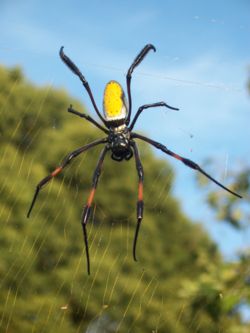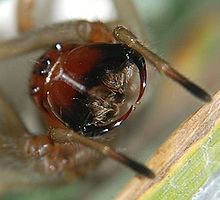Araneomorphae

Multi tool use
| Araneomorph spiders | |
|---|---|
 | |
Nephila inaurata (Nephilidae) | |
Scientific classification | |
| Kingdom: |
Animalia |
| Phylum: |
Arthropoda |
| Class: |
Arachnida |
| Order: |
Araneae |
| Suborder: |
Araneomorphae |
| Families | |
see Table of families | |
Diversity | |
95 families | |

Hippasa agelenoides- Common Funnel web spider
The Araneomorphae (also called the Labidognatha) are a suborder of spiders. They are distinguished by having chelicerae (fangs) that point diagonally forward and cross in a pinching action, in contrast to the Mygalomorphae (tarantulas and their close kin), where they point straight down. Most of the spiders that people encounter in daily life belong to the Araneomorphae.
Contents
1 Distinguishing characteristics
1.1 Mygalomorphae
1.2 Araneomorphae
2 Spiders included
3 Systematics
4 References
Distinguishing characteristics
Note the difference in the orientations of the chelicerae (fangs) of the two spiders below, representatives of the Mygalomorphae and the Araneomorphae.
Mygalomorphae

Atrax robustus

Cheiracanthium punctorium
This Atrax robustus (a member of the Hexathelidae) is making a threat display, and by so doing shows very clearly the orientation of its chelicerae, which go up and down, parallel to the long axis of the spider's body. So it is a representative of the suborder Mygalomorphae, not Araneomorphae.
Araneomorphae
In Araneomorphae, the fangs slope towards each other, giving these spiders many more possibilities than Mygalomorphae, which can only bite top down.
Unlike Mygalomorphae, which can live for up to 25 years, most Araneomorphae die after about a year. [1]
Spiders included
Almost all of the familiar spiders are included in this group. The major exception is the Tarantulas, which have become so common as pets that many people have seen them. There are a few other members of Mygalomorphae that one might see around homes or gardens, but they typically are relatively small and not easily noticed. For instance, the females of one such species lives and hunts from within a long silken tube, so unless one opens the tube or chances upon a male looking for a mate, one will never see them. The Araneomorphae, to the contrary, include the weavers of spiral webs, the cobweb spiders that live in the corners of our rooms and between windows and screens, the crab spiders that lurk on the surfaces of the flowers in our gardens, the jumping spiders that look back at us curiously from walls and tree trunks, the wolf spiders that sometimes carpet good hunting sites in a sunny spot in the lawn, the large Huntsman spiders that sometimes frighten people by getting into their cars or taking up residence behind wall clocks.
Systematics
The Araneomorphae are divided into two infraorders, the Hypochilae (containing only the family Hypochilidae), and the Neocribellatae. The Neocribellatae are in turn divided into the Austrochiloidea, and the two series Entelogynae and Haplogynae, each containing several superfamilies:
A cladogram shows the relation among taxons.[1]
.mw-parser-output table.clade{border-spacing:0;margin:0;font-size:100%;line-height:100%;border-collapse:separate;width:auto}.mw-parser-output table.clade table.clade{width:100%}.mw-parser-output table.clade td{border:0;padding:0;vertical-align:middle;text-align:center}.mw-parser-output table.clade td.clade-label{width:0.8em;border:0;padding:0 0.2em;vertical-align:bottom;text-align:center}.mw-parser-output table.clade td.clade-slabel{border:0;padding:0 0.2em;vertical-align:top;text-align:center}.mw-parser-output table.clade td.clade-bar{vertical-align:middle;text-align:left;padding:0 0.5em}.mw-parser-output table.clade td.clade-leaf{border:0;padding:0;text-align:left;vertical-align:middle}.mw-parser-output table.clade td.clade-leafR{border:0;padding:0;text-align:right}
| Opisthothelae |
|
||||||||||||||||||||||||||||||
| |
Most spiders in the Haplogynae series have six eyes, while most of those in the Entelegynae series have eight.
References
| Wikimedia Commons has media related to Araneomorphae. |
Wikispecies has information related to Araneomorphae |
^ Coddington and Levi (1991)
xItIFTHuLdjqguAF6b 1ZWZLzJCmM8kULskx3M3,AWL97VATLwcCprg,k1,DEsUVu3EoolNP,nADLp wztO1JO,UvmYA 4XBdc587
